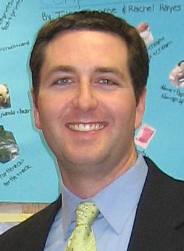I really think that learning 21st Century Skills begins with 21st century teaching, with teachers acting as facilitors in the learning process. We need to look at the way that we (educators) approach teaching, lesson planning, and classroom setup. In a 21st century classroom, the students are intrinsicically motivated to learn because they have the ability to collaborate, the knowledge and resources to find and use information, and the skills to communicate thier knowledge with the global community.
Here is a link to a wiki space that, in my opinion, is an excellent collection of the free 21st century tools that are available to students and teachers. Wouldn't the results be amazing if teachers presented their classes with this page and allowed for them to choose how they were going to demonstrate what they learned about a certain topic?
Below, I have posted some of the projects from my classroom that I feel illustrate many of these 21st Century Skills. I embedded some of them into my e-portfolio with a free online document program called Scribd. The documents below are interactive, so you can click on them, zoom in or out, download them in various formats, and even listen to them as an mp3! Have fun!
Bienvenidos from Mexico
When collaborating with two other teachers for a Cinco de Mayo celebration, my responsibility was to teach the students about the history of the holiday. After some research and planning, I created an activity using Visual Communicator and a green screen that would have the students broadcast as news anchors "live" from Puebla, Mexico--the site of the Cinco de Mayo battle. Not having used this technology before, I was unsure of how everything would "come together". I wanted the students to have an engaging experience, but I also wanted to make sure that I fulfilled my objective and that they left with some knowledge about the holiday's history. Below is a sample of the resulting broadcast.
The Parts of a Cell using Photo Story 3
Examining our 5th Grade Curriculum Map within Rubicon Atlas, I found that students needed to be able to name and describe the various parts of an animal cell. I have taught this in the past using various diagrams and websites, such as Cells Alive, but I never really felt that the students were fully engaged in the learning process because it was such an abstract concept for them. I was familiar with Photo Story and had used it in class for some fun projects, but it was usually me (instead of the students) creating the document and doing most of the legwork. With a little brainstorming, I came up with the idea of having the students make short movies about the parts of a cell with Photo Story. I took a risk, not having done this project before, and it was a tremendous success. The students were engaged in every part of the process, from the drawing, to the script-writing, and to the collaboration on the laptops in Photo Story. I can honestly say that the students left with not only the scientific knowledge about the cell, but also knowledge about how technology can be a tool for learning. Click on the image below to view a sample.

Digital Geometry
Geometry is a large part of our NYS Core Curriculum in 5th grade, and I think that many geometric concepts lend themselves well to technology integration. The students and I created this project together--I showed them the content that they needed to learn, along with the tools they had to do so (digital cameras and laptops), and they came up with the idea below. In teams of 2 or 3, the students traveled throughout the school and took digital photos of geometric figures. When they returned to the classroom, they put together presentations in either Photo Story or PowerPoint to demonstrate their knowledge. The results were outstanding. Take a look at the sample.
*Please note: If the PowerPoint does not appear below, please click here to view it in a new window.
Quarterly Newsletter
When I began teaching, I wanted to design a system that would share what we were doing in our classroom with parents and the community. I also wanted the students to play a large role in this, giving them some choice and ownership. Our final decistion was to create a newsletter that would be written quarterly and delivered in paper form, digitally online, and even in audio format (via a podcast). Each quarter, a team of students utilizes Publisher, Excel, Word, and an assortment of other programs to write, design, and deliver our newsletter. Click the image below to view a sample.
Literature Circles University
I have used literature circles in my classroom for about 5 years and it has been a powerful reading comprehension tool for my students. Many of my colleagues in each of the 4 school buildings on campus have sought my knowledge and/or have observed the literature circle team meetings in my classroom.
It takes a significant amount of "training" for the students to participate in these team meetings, so a few years ago, my class and I wrote, filmed, and produced a "Literature Circles University" DVD that would train other teachers and student in literature circles. It was a great opportunity for the kids to be able to contribute something significant to their peers and to the faculty of our district. The DVD is available, at your request.

